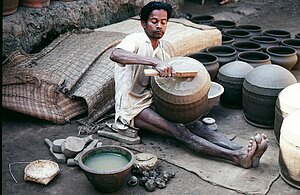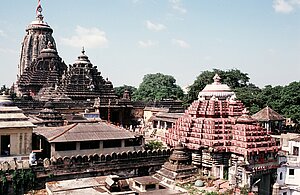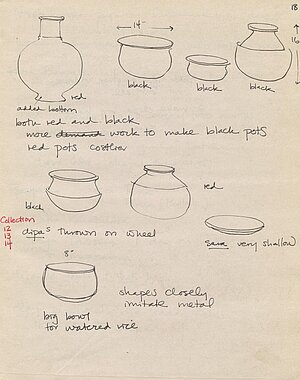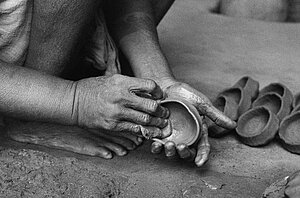Temple Potters of Puri
An archive by Louise Allison Cort and Purna Chandra Mishra
The Kumbhara Bishoi are a distinctive community of potters who, as hereditary temple servants (sevaka) of the Jagannath Temple in the city of Puri, Odisha (formerly Orissa), supply a repertory of earthenware cooking and serving pots to the temple kitchen. As a pilgrimage center of national importance, the Jagannath Temple requires new earthenware vessels in great quantities for the daily production, offering, and distribution of the sacred food (mahaprasad) that is an indispensable feature of ritual and pilgrimage. Centering on rice and including traditional vegetarian dishes, the sacred food is offered to the deities of the temple five times each day before being distributed to temple servants and pilgrims. Auspicious red color and faceted surfaces distinguish the earthenware vessels admitted to the temple kitchen for the purpose of preparing this food from the plain black cooking pots made for the ordinary market. Each vessel is used just once in the kitchen, in order to preserve the ritual purity imbued by the flames of the potter’s kiln. The role of the Kumbhara Bishoi potters is to replicate perfectly the prescribed vessel color, forms, and sizes and send a steady stream of identical new vessels to the temple. Male potters, carefully trained in the repertory and formally inducted as temple servants by receiving a cloth once draped on the sacred images, provide the cooking vessels; their wives prepare smaller, hand-formed serving bowls and lamps. The potters live in three villages on the outskirts of Puri—Kumbharapada, Tikarapada, and Gopalpur.
Records of the Kumbhara Bishoi reach deep into the past and mytho-history. The Kumbhara Bishoi proudly trace their origins in a text, the Kurala Purana, which relates how Vishnu created the first potter to provide pots for preparing the cooked food that would distinguish humans from animals. The text is read aloud each year as part of the potters’ annual observation of Kurala Panchami, a multi-day interval when the potters clean, decorate, and worship the tools of their craft—the workshop, the kiln, the wheel, and the paddle and anvil and other implements. The potters also revere the legend of their ancestor, the potter’s wife Neli Kumbharuni, whose devotion to her service of delivering pots to the temple earned the right to occupy the land where the potters now live and work. Records of the induction of successive new generations of male potters as temple servants appear in the temple’s administrative records, the Madala Panji. Documents of struggles over the potters’ landholding survive in British colonial archives. Simultaneously, however, the potters experience tensions arising from the brutality of caste-based hierarchy and cash-based exchange penetrating the modern temple’s daily operations.
This archive centers on a collaborative study of the Kumbhara Bishoi community conducted by Louise Allison Cort and Purna Chandra Mishra between October 1979 and February 1981. Our study benefited from the timely publication of The Cult of Jagannath and the Regional Tradition of Orissa, edited by A. Eschmann, H. Kulke and G. C. Tripathi (Manohar 1978), which summarized the findings of the Orissa Research Project, based at the South Asia Institute, University of Heidelberg. Our study built upon that volume’s comprehensive religious and political history of Orissa and the Jagannath Temple in order to focus on a single category of temple servant, one among the many dozens of sevaka groups whose interlocking activities perpetuate the temple’s daily and cyclical operations and, notably, one of low- ranking Shudra caste. Through almost daily visits to the potters’ community in the village of Tikarapada, we built friendships with community members ranging from the senior men and their wives to the young men and their brides and children. Through ongoing conversations, we compiled life histories and witnessed ongoing developments within individual lives, households, and the community, including conflicts with the temple cooks and struggles to maintain a sense of pride as sevakas contrasting to the reality of their social standing.
Fieldnotes
The archive contains eleven numbered notebooks (I – XI) spanning October 1979 to February 1981, in which Louise Cort recorded daily visits to the three villages of the Kumbhara Bishoi, frequent discussions with Purna Chandra Mishra, notes from reading, and other information. These notebooks constitute the core records for our research.
Sometimes Louise compiled information from the notebooks and discussions into typed summaries. We devised and used a standardized mimeographed form to record a series of conversations with individual potters held by appointment in Louise Cort’s residence. Together we translated a printed version of the potters’ origin story, the Kurala Purana.
The archives also hold three notebooks (Heidelberg I–III) compiled during our 1984 research visit to the Archives of the South Asia Institute, University of Heidelberg. Of special importance during that visit was the opportunity to review transcriptions of the temple administrative record Madala Panji, which contained records of the potters as temple servants in the nineteenth and twentieth centuries. We also studied, copied, and annotated other relevant documents collected by the Orissa Research Project. We found and translated a second version of the Kurala Purana, which is included in the archive.
The archive includes separate notebooks used for records concerning potters and pottery seen during travels outside Puri, elsewhere in Orissa as well as to Western and Southern India; on textile production; on other crafts; and on food, including mahaprasad as well as daily and festival foods in Puri.
Photography
The photography for this project included 35mm black-and-white images, 35mm color slides, and 16mm color film footage. Louise documented all three media in a notebook that is included in the archive. Our book Temple Potters of Puri (2012) published 268 black-and-white and color images and included a DVD holding a film edited from the digitized film footage.
All the black-and-white negatives and color slides and the edited film on DVD are included in this archive. The original 16mm film footage is housed in the National Anthropological Film Collection (formerly the Human Studies Film Archives), National Museum of Natural History, Smithsonian Institution, Washington DC., HSFA.1984.08. Read more …






